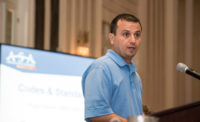The ASA Codes and Standards team hit the ground running in 2024 by attending major standards/model codes meetings impacting our members. ASA continues to be committed to representing ASA members and being the voice of the PHCP/PVF supply chains in the development of sound and fair standards and codes. In addition, ASA Codes and Standards staff represent both HARDI and the Water Quality Association (WQA), through partnership agreements, at these meetings.
ASA is represented as a voting member on the ASME A-112 Standard Committee. The ASME A112 standards create a comprehensive series comprised of more than 40 plumbing standards that provide expectations for performance and tests for a wide range of plumbing products and assemblies. Many of the ASME plumbing standards are harmonized with the Canadian Standards Association plumbing standards so participation on the A-112 Committee provides additional value in having a voice on how Canadian standards impact plumbing products.
Key highlights from the ASME/CSA meetings include:
- The committees are getting closer to the development of a more efficient process for the review of proposed standards in the ASME/CSA standards harmonization process. The current process involves significant duplication and inefficiencies which have a direct impact on our manufacturing members’ time spent on the process. The new processes are anticipated to be submitted for approval at the June meeting.
- Significant time was spent on the incorporation of United Nations Sustainable Development Goals into the forward of CSA and harmonized ASME/CSA plumbing standards. CSA has moved forward with including a forward into CSA standards which attempts to document which UN Sustainable Development Goals are addressed in the standard. A major concern from committee members, including ASA, is that the inclusion of such a forward would give a misunderstanding that the plumbing standards are intended to cover sustainability requirements. The plumbing standards today cover performance and public safety and there was not strong support for the potential inclusion of sustainability requirements. ASA will be represented on a task group to address this issue and provide recommended actions to both CSA and ASME. Until resolution of the issue is obtained, CSA agreed to take down the references to UN Sustainable Development Goals related to plumbing standards currently on the CSA website.
- Update Report from EPA WaterSense – the US EPA WaterSense staff provided a summary report on their activities:
- EPA is establishing a singular maximum flush volume requirement of 1.28 gpf for both single-flush toilets and the full-flush mode of dual-flush toilets. Prior to this change, dual flush toilets were allowed to have a maximum flush of 1.6 gpf with the average of the dual flush volumes being below 1.28 gpf. The program is in the process of obtaining public input on the timeframe for compliance with the new requirements. ASA staff obtained clarification during the presentation that products already in the marketplace, including distributor inventory, will not be impacted by this change.
- EPA will be publishing a notice of intent soon to revise the requirements for high efficiency lavatory faucets. The proposed revisions under consideration include expanding scope to include private lavatory and bar sink faucets, kitchen faucets, and public lavatory faucets; incorporating metering or self-closing lavatory or public faucet categories; and exclusion of laundry tub/tray and service sink faucets, lawn or sediment faucets, deck mounted tub faucets, pot fillers, and water dispensers. The ASA Codes and Standards Committee will review the notice, once published, for possible comment.
ASA also participated in standards meetings held at the ASHRAE Winter Conference.
The following provides key highlights from those meetings:
ASHRAE 90.2 Standards Committee
ASA has had a standing opposition to the incorporation of water efficiency requirements into ASHRAE Standards covering energy-efficiency. During the ASHRAE 90.2, Energy-Efficient Design of Low-Rise Residential Buildings, committee meeting a presentation was provided on the incorporation of water efficiency requirements into ASHRAE 90.2. ASA spoke in opposition to the concept and no action was taken during the meeting.
ASHRAE Technical Committee 3.6, Water Treatment
A report was provided on the status of approval of a research project to produce a publication on requirements of state and local agencies related to building facilities that provide supplemental treatment to building water systems.
Two additional research projects have been submitted for approval and funding. The first is a project to evaluate the effects of high dosing disinfection practices on the building water system materials. The second research project is to evaluate the recycling of greywater on the building plumbing system materials.
ASHRAE 15 and 15.2 – Refrigeration Systems, Commercial and Residential
ASA is represented as a voting member on both the ASHRAE 15 and ASHRAE 15.2 Committees. No significant outcomes to report from the Committee meetings. Several revisions to the Standards will be coming out for vote to clarify several requirements and provide editorial updates.
A new standard is under consideration for covering refrigeration systems used in transportation. Specifically, the following applications will be covered: on road transport, refrigerated rail units and refrigerated boxcar, self-contained marine, intermodal transport, and passenger buses and trains.
As always, if you have any questions concerning codes and standards activities, please do not hesitate to contact Jim Kendzel, director of codes and standards, at jkendzel@asa.net.







